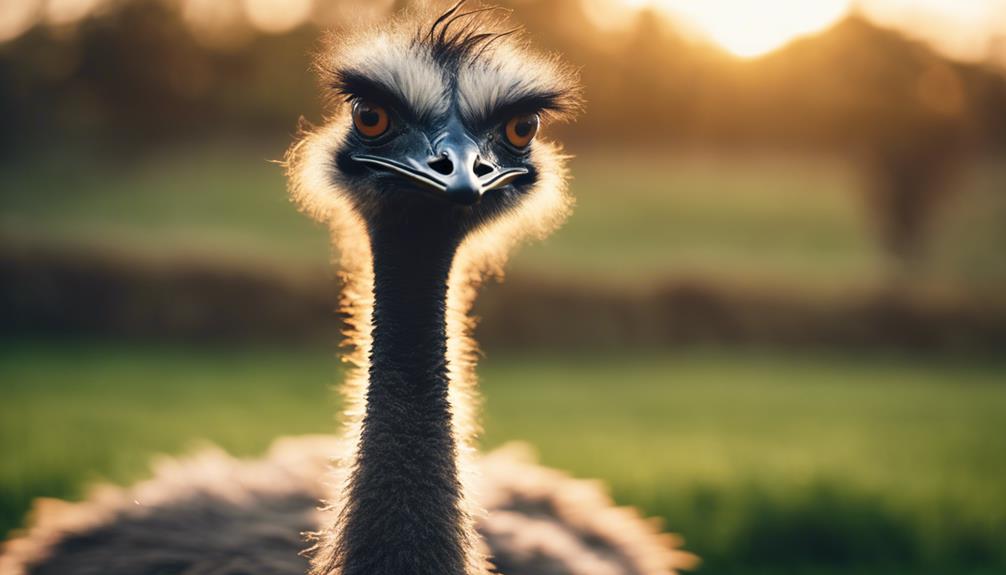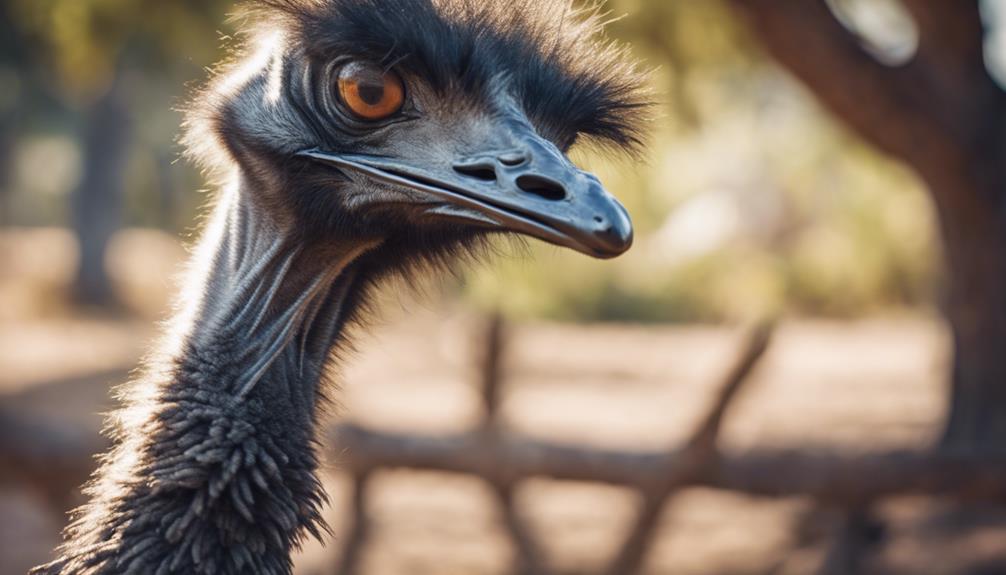
As you explore the world of emu vocal patterns, you'll uncover a realm where sounds convey more than mere noise. Each call, each utterance holds a key to unlocking the intricate tapestry of communication that these majestic birds weave. From the depths of the outback to the heart of their communities, emus have a language all their own. Intriguingly, what lies beneath the surface of these vocalizations may surprise you, offering a glimpse into a world where every sound tells a story.
Key Takeaways
- Emu vocal patterns convey messages on behavior and social interactions.
- Variation in pitch, duration, and frequency carries specific meanings.
- Vocalizations used for dominance, courtship, social signals, and alarms.
- Diverse vocal repertoire aids in communication and adaptation.
- Insights into emu societies and communication networks through decoding vocalizations.
The Significance of Emu Vocalizations

Emu vocalizations play a crucial role in communication among these large flightless birds, conveying important messages about their behavior, emotions, and social interactions. These vocalizations are characterized by deep booming sounds that can travel long distances, allowing emus to communicate effectively across their habitats. The pitch, duration, and frequency of their calls all carry specific meanings, contributing to the complexity of their vocal language.
Emus use vocalizations to establish dominance within their social hierarchy. The intensity and frequency of their calls can signal aggression or submission, helping to maintain order within their groups. Additionally, emus utilize vocalizations to attract mates during breeding seasons, with males producing low-frequency calls to demonstrate their fitness and attract females.
Understanding the significance of emu vocalizations provides valuable insights into their behavior and social dynamics. By decoding the messages embedded in their calls, researchers can unravel the intricate communication systems that emus have developed to thrive in their environments.
Vocalization Types and Functions
Within the realm of ornithology, the classification of vocalization types and their corresponding functions is a fundamental aspect of understanding avian communication. Emus exhibit a diverse range of vocalizations, each serving distinct purposes.
The most common vocalization types observed in emus include booming calls, drumming sounds, and grunting noises. Booming calls are often associated with breeding behavior, serving as a means for males to attract females and establish dominance. Drumming sounds, produced by specialized air sacs, are primarily used during courtship displays to impress potential mates.
Additionally, emus emit grunting noises as a form of social communication, signaling alarm or distress within the group. Understanding the specific functions of these vocalization types provides valuable insights into emu behavior, social dynamics, and overall reproductive success.
Evolution of Emu Calls

The evolutionary trajectory of emu calls can be traced back through millennia, unveiling a complex interplay of selective pressures and behavioral adaptations. Emus, as ancient flightless birds, have developed a sophisticated vocal repertoire over time to navigate their environments, establish territories, and communicate with conspecifics. This evolution of emu calls showcases a fine-tuned system that has allowed these birds to thrive in various habitats across Australia.
To better understand the evolution of emu calls, let's explore a table showcasing some key vocalizations and their potential functions in emu communication:
| Call Type | Description | Function | Context |
|---|---|---|---|
| Booming | Low-frequency, resonant calls | Attracting mates | Breeding season |
| Grunting | Short, repetitive vocalizations | Expressing alarm | Predator detection |
| Drumming | Rapid, rhythmic beats | Signaling dominance | Territory defense |
| Whistling | High-pitched, melodic sounds | Locating group members | Social cohesion |
This table provides a glimpse into the diverse vocalizations that have evolved in emus, highlighting their adaptive significance in various contexts.
Emu Communication in the Wild
Tracing the intricate patterns of emu vocalizations in the wild reveals a nuanced communication system shaped by evolutionary pressures and environmental dynamics. In the vast expanse of the wild, emus employ a diverse array of vocalizations to convey crucial information and maintain social bonds. Here's a glimpse into the captivating realm of emu communication:
- Territorial Calls: Emus use deep, booming calls to demarcate their territories and warn off intruders with powerful resonance.
- Mating Serenades: Male emus produce drum-like beats and melodious calls to attract females, showcasing their vitality and genetic fitness.
- Parental Guidance: Adult emus communicate with soft clucks and gentle murmurs to guide their chicks, fostering familial bonds and ensuring survival.
- Alarm Signals: Emus emit sharp, high-pitched calls to alert their group of potential threats, facilitating swift responses and collective protection.
Within the intricate tapestry of emu vocalizations, each sound serves a precise purpose, reflecting the evolutionary wisdom of these majestic birds.
Studying Emu Vocal Patterns

Deciphering the intricate vocal patterns of emus provides crucial insights into their communication strategies and social dynamics in the wild. Emus, being highly vocal birds, utilize a diverse range of sounds to convey messages within their groups. By studying these vocalizations, researchers can unravel the complexities of emu interactions and better understand their behavior.
To delve deeper into the world of emu vocalizations, let's examine a simplified version of the different types of sounds emus produce:
| Sound Type | Description | Purpose |
|---|---|---|
| Booms | Deep, resonant calls | Attracting mates and signaling danger |
| Grunts | Short, low-pitched noises | Expressing contentment or curiosity |
| Whistles | High-pitched, melodic sounds | Used in communication over long distances |
Each of these vocalizations plays a distinct role in the emus' social structure and communication network. By decoding these patterns, scientists can gain valuable insights into the inner workings of emu societies and how these fascinating birds interact with one another in their natural habitat.
Emu Mating Calls Unmasked
Studying the distinct vocal patterns of emus sheds light on their intricate mating calls, revealing the complexity of their communication strategies during the breeding season. Emus, with their unique vocalizations, employ a range of calls to attract mates and establish dominance. Here's a breakdown of their mating calls:
- Booming Calls: Male emus produce deep, resonant booms that can carry over long distances, signaling their presence to potential mates.
- Drumming Sounds: During courtship displays, male emus create drumming sounds by inflating their necks and creating vibrations, showcasing their fitness to females.
- Soft Grunts: Female emus respond to male displays with soft grunts, indicating their receptiveness to mating.
- Contact Calls: Emus maintain communication with their chosen partners through gentle grunts and murmurs, strengthening their bond during the breeding season.
Understanding the nuances of these mating calls provides insight into the intricate social dynamics and reproductive behaviors of emus in the wild.
Deciphering Warning Calls

Emus emit distinct warning calls in response to potential threats, signaling imminent danger to their group members. These warning calls serve as a crucial form of communication within the emu community, allowing individuals to alert others of nearby predators or dangers.
The vocalizations are characterized by a series of short, sharp sounds that convey a sense of urgency and alarm. Through careful observation and analysis, researchers have identified specific patterns in these warning calls that indicate the type and level of threat perceived by the emus.
For instance, a higher pitch or increased frequency may signify a more immediate danger, prompting a quicker response from the group. Understanding these warning calls is essential for the survival of emus in the wild, as it enables them to coordinate their actions and protect each other from harm.
Social Interactions Through Vocalizations
In the context of emu vocalizations, the patterns and frequencies of their calls play a vital role in facilitating intricate social interactions within the group. Emus utilize their vocalizations to convey various messages and establish hierarchies within their communities.
Here are four key ways emus use vocalizations for social interactions:
- Establishing Dominance: Emus often use low-frequency calls to assert dominance and establish their rank within the group.
- Courtship Rituals: High-pitched vocalizations are common during courtship displays, signaling readiness to mate and initiating the breeding process.
- Warning Calls: Emus emit loud, harsh calls to warn others of potential threats or dangers in the environment, promoting group safety and survival.
- Maintaining Social Bonds: Through softer, melodious calls, emus reinforce social bonds, strengthen relationships, and promote cohesion within the group.
Understanding these nuances in emu vocalizations provides valuable insights into the intricate social dynamics of these fascinating birds.
Emu Vocalizations Vs. Other Birds

Comparison of vocalization patterns between emus and other avian species reveals distinct characteristics that contribute to understanding their unique communication strategies. Emus, known for their deep booming calls, use these vocalizations primarily for long-distance communication.
In contrast, other bird species such as songbirds often produce complex melodies for territorial defense or attracting mates. Emus exhibit a more limited vocal range compared to birds like nightingales or mockingbirds, whose intricate songs serve varied purposes.
While emus rely on low-frequency sounds that travel efficiently across vast open spaces, other birds utilize a diverse range of pitches and tones to convey intricate messages. Understanding these differences sheds light on how emus have evolved to thrive in their environment through efficient and powerful vocalizations.
Vocal Learning in Emus
Decoding the mechanisms of vocal learning in emus reveals fascinating insights into their communication abilities and evolutionary adaptations. When it comes to vocal learning in these majestic birds, here's what you need to know:
- Complex Vocal Repertoire: Emus display a diverse range of vocalizations, from booming calls to soft grunts, showcasing their ability to learn and produce various sounds.
- Social Learning: Emus have been observed to learn vocalizations by mimicking other emus, indicating a level of social learning in their communication patterns.
- Memory Skills: These birds exhibit impressive memory retention for vocalizations, enabling them to recall and reproduce specific sounds over time.
- Adaptability: Vocal learning in emus allows for adaptability in their communication strategies, aiding in survival and successful interaction within their environments.
Understanding the intricacies of vocal learning in emus provides a glimpse into the sophisticated communication systems these birds have developed, highlighting their prowess in vocalization and social dynamics.
Emu Call Diversity Across Regions

Emu vocal patterns exhibit notable variations across different regions, reflecting the diverse acoustic landscapes these birds navigate in their communication repertoire. The calls of emus in the arid regions of Australia, for instance, tend to be lower in frequency and more resonant, possibly due to the open, flat terrain that characterizes these areas. In contrast, emus in densely forested regions produce calls with higher frequencies and shorter durations, which may help the sound travel better through the cluttered vegetation. These regional differences in vocalizations suggest that emus have adapted their calls to suit the specific environmental conditions they inhabit.
Furthermore, studies have shown that emus in regions with higher predator densities tend to have calls that are more complex and varied, possibly as a strategy to confuse or deter potential threats. This indicates that emus possess a remarkable ability to adjust their vocalizations based on the unique challenges present in their respective habitats. By understanding these variations in emu calls across different regions, researchers can gain valuable insights into the evolutionary and ecological factors shaping the vocal communication of these fascinating birds.
Implications for Conservation Efforts
Understanding the regional variations in emu vocal patterns can provide crucial insights for enhancing conservation efforts aimed at preserving these unique bird species. By decoding the significance of emu vocalizations, conservationists can tailor strategies to better protect and manage emu populations.
Here are four key implications for conservation efforts:
- Population Monitoring: Analyzing vocal patterns can aid in monitoring emu populations across different regions, helping conservationists track changes and identify areas that require immediate attention.
- Habitat Management: Recognizing specific vocalizations linked to habitat preferences can guide conservation practices to ensure the preservation and restoration of suitable environments for emus.
- Behavioral Studies: Studying emu vocalizations can offer valuable insights into their behavior, social interactions, and response to environmental factors, enabling more informed conservation decisions.
- Threat Assessment: Understanding how emus alter their vocalizations in response to threats can assist in assessing potential risks and implementing effective conservation measures to mitigate these dangers.
Frequently Asked Questions
Do Emus Have Regional Dialects in Their Vocalizations?
Yes, emus do have regional dialects in their vocalizations. These distinct variations are influenced by factors such as habitat, social interactions, and individual differences. Understanding these nuances can provide valuable insights into emu communication patterns.
Can Emus Mimic Human Sounds in Their Calls?
Yes, emus can mimic human sounds in their calls. This behavior showcases their adaptability and intelligence. By imitating human sounds, emus demonstrate a remarkable ability to learn and reproduce a wide range of vocalizations beyond their typical repertoire.
How Do Emus Use Their Vocalizations to Establish Dominance?
To establish dominance, emus utilize a variety of vocalizations including booming calls, drumming sounds, and grunts. These vocal signals convey strength, territorial ownership, and readiness to defend their space, asserting authority within their social hierarchy.
Are There Specific Calls Emus Use to Communicate With Their Young?
When communicating with their young, emus employ specific calls to convey safety, guidance, and reassurance. These vocalizations serve as a vital tool in nurturing and teaching their offspring, fostering strong familial bonds within the emu community.
Do Emus Use Vocalizations to Warn Each Other About Predators?
Emus emit distinct vocalizations to alert others about predators. Their calls vary in pitch and duration, conveying urgency and danger levels. These warning signals are crucial for group survival, enabling swift responses to potential threats in their environment.
Conclusion
As you delve into the intricate world of emu vocal patterns, you uncover a symphony of communication strategies that shape their social dynamics.
From booming calls that echo through the outback to subtle drumming sounds during courtship, each vocalization plays a crucial role in their complex society.
Just like notes in a musical composition, these vocalizations paint a vivid picture of the rich tapestry of behaviors and relationships within emu populations.




